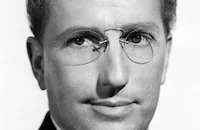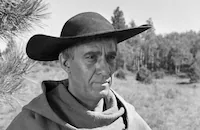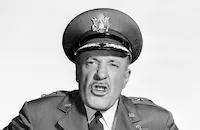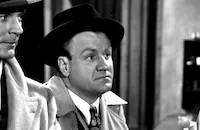Ride the Pink Horse

Brief Synopsis
Cast & Crew
Robert Montgomery
Robert Montgomery
Thomas Gomez
Rita Conde
Iris Flores
Wanda Hendrix
Film Details
Technical Specs

Synopsis
Veteran Lucky Gagin arrives in the New Mexico town of San Pablo, where he hopes to blackmail Frank Hugo, a former war profiteer who murdered his friend, Shorty Thompson. After hiding a canceled check inside a bus terminal locker, Lucky meets Pila, a young Mexican American girl, who gives him a good luck charm. Lucky then goes to Hugo's hotel room, where he has a run-in with Hugo's secretary, Jonathan. There, he also meets Marjorie, Hugo's gold- digging girl friend. Upon leaving Hugo's room, Lucky is invited to lunch by Bill Retz, a government agent, who warns Lucky against avenging Shorty's death. With all the town's hotel rooms filled because of an upcoming fiesta, Lucky goes to the Cantina de las tres violetas, where he meets Pancho, a carousel operator. After a evening of drinking, the drunken Lucky and Pancho spend the night at the Mexican's outdoor domicile. They are soon joined by the homeless Pila, who falls asleep on Pancho's merry-go-round. Later, Retz arrives and warns Lucky that Locke, Hugo's partner, has hired two thugs to kill him. The next morning, Lucky meets with Hugo, who is deaf, and he admits to having killed the blackmailing Shorty. Lucky then tells Hugo that he has a canceled check for $100,000 which Hugo used to bribe a high government official, and demands $30,000 for its return. Hugo concedes to Lucky's demands, and they agree to meet that night at the Tip Top Café. Marjorie then offers to join forces with Lucky, hoping to blackmail Hugo for even more money, but Lucky refuses. That night at the café, Marjorie lures Lucky outside, where he is attacked and stabbed by two of Hugo's men. Lucky defeats the mobsters, killing one, and escapes into the woods. Pila finds him, the she and Pancho tend to his wounds and hide him from Hugo's thugs. Lucky and Pila later go back to the cantina, where he gives her the canceled check. Red, one of Hugo's goons, arrives at the cantina, but he is knocked unconscious by Pila, who then places the semi-conscious Lucky inside a bus. As she tries to find the ticket master, however, Lucky wanders back into town. Before Pila can stop him, Lucky arrives at Hugo's room, and they are both beaten up by Hugo's men because the injured Lucky cannot remember where the check is. They are saved by Retz, and after Hugo offers him $300,000 for the check, Lucky defiantly gives the check to the government agent. A few days later, Lucky frets about how he is going to leave town without breaking Pila's heart, but it is she who says goodbye to him, making her the envy of all her friends.

Director

Robert Montgomery
Cast

Robert Montgomery

Thomas Gomez
Rita Conde
Iris Flores
Wanda Hendrix
Grandon Rhodes
Tito Renaldo

Richard Gaines

Andrea King
Art Smith

Martin Garralaga
Edward Earle
Harold Goodwin
Maria Cortez

Fred Clark

Paul Maxey
Howard Negley
Jimmy Ames

John Doucette
Jack Worth
Leon Lenoir
Beatrice Roberts
Julian Rivero
Jerry De Castro
Paul Bryar

Lyle Latell
Harry J. Vejar
Charles Stevens
William Ruhl
Ernest Hilliard
Virginia Ware
Ralph Montgomery
Amadita Garcia
Connie Asins
Rose Marie Lopez
Martha Brenes
Olga Perez
Carmen Pallais
Miguel Tapia
Roque Ybarra Jr.
José Alvarado
Robert Espinoza
Harry Garcia
Enrique Valadez
Robert Cabal
Donald Kerr
Margarita Savilla
Kenneth Ross-mackenzie
Crew
Jack A. Bolger Jr.
Robert Boyle
Leslie I. Carey
Ralph Dawson
Carmen Dirigo
Oliver Emert
Russell A. Gausman
Maury Gertsman
Joan Harrison
Ben Hecht
Bernard Herzbrun
Charles Lederer
Russell Metty
John F. Sherwood
Frank Skinner
David Tamkin
Bud Westmore
Yvonne Wood

Film Details
Technical Specs

Award Nominations
Best Supporting Actor
Articles
Ride the Pink Horse
In the film, Montgomery portrays Lucky Gagin, a bitter WWII vet who had nothing but a life of petty crime waiting home for him after V-J Day. The screenplay, a somewhat loose adaptation by Ben Hecht and Charles Lederer from the Dorothy B. Hughes novel, opens with him being deposited at the bus station of a dusty New Mexico city. What's brought him to town is the chance to confront Frank Hugo (Fred Clark), a vicious and semi-deaf crime lord with the disconcerting habit of receiving phone calls into a belt-mounted hearing aid. As it develops, Gagin's in possession of a canceled check that would tie Hugo to acts of war profiteering, and will only give it up for a price. Lucky's motives for squeezing Hugo are more than merely mercenary; the gangster had his best friend killed for attempting to run the same blackmail.
An elfin Mexican girl named Pila (Wanda Hendrix), filled with an odd fascination for this newly-arrived gringo, leads him to the town's hotel district, currently filled to overflow because of fiesta season. In his failed efforts to find lodging, Gagin encounters Retz (Art Smith), an older, cagey federal agent who's long been shadowing Hugo, and who patiently entreats Lucky to turn over whatever it is that he has that'll put the mobster away. Uninterested, Gagin hits the street in search of somewhere to sleep. He has but to buy a round at a local bodega to get an offer from the gregarious, rotund Pancho (Thomas Gomez), who happily shares his domicile: a lean-to adjacent to the city's antique carousel, which he operates. The danger level escalates for Gagin and his new acquaintances once Hugo sets his thugs out with the mission of recovering the evidence sans payoff.
Montgomery's first acting assignment in Hollywood upon his return from naval service was John Ford's They Were Expendable (1945), and he was handed quite the surprise after Ford broke his leg during the waning days of the shooting schedule. While visiting Ford in the hospital, the actor recalled in a 1980 interview, Ford took a call from the studio, which wanted to know when he anticipated returning to the set. "He said: 'I'm not coming back...I'm staying here and getting my leg right. Then I'm going back to the Navy. Montgomery'll finish the picture.' That was the first I heard of it. It was quite the shock."
The experience whetted his appetite, and he thereafter served as director/star for an MGM project which would also come to be recognized as a noir staple, in adapting Raymond Chandler's Lady in the Lake (1947). In stepping into the role of Philip Marlowe, Montgomery kept the camera's perspective in the first person for the duration of the film, and only appeared on-screen for the occasional glance in a mirror. This willingness to take narrative chances would serve him well in Ride the Pink Horse, as evidenced by the single sustained shot during the opening minutes that finds him disembarking from the bus and concealing the all-important check within the station.
Beyond leading the viewer through this morally ambiguous universe with an assured directing touch, Montgomery is never less than wholly credible in his performance as the disillusioned, laconic thug Gagin ("He had what it takes. Dough.") Beyond plentiful location shots in Santa Fe, Universal arranged for the same 65-year-old Taos merry-go-round that had inspired Hughes' prose to be deconstructed, shipped to Universal City, and rebuilt.
Ride the Pink Horse also benefits from the more than capable efforts of the supporting players. Gomez, mostly remembered today for playing heavies (in every sense of the term) like his turn as Curley in Key Largo (1948), gives a most memorable performance here. Playing a character one initially expects to roll Gagin at the first opportunity, and who ultimately stands revealed as the most honorable figure in the film, Gomez received a Best Supporting Actor Oscar® nomination, the only such nod from the Academy that the feature received. The petite and pretty Hendrix brought an almost otherworldly quality to her characterization of Pila, and her work is arresting. It's too bad that no other role, or performance, of this caliber would be forthcoming from the balance of her career, which was checkered in part by a brief and tumultuous marriage to Audie Murphy.
Producer: Joan Harrison
Director: Robert Montgomery
Screenplay: Joan Harrison, Ben Hecht, Charles Lederer, Dorothy B. Hughes (novel)<
Cinematography: Russell Metty
Film Editing: Ralph Dawson
Art Direction: Robert F. Boyle, Bernard Herzbrun
Music: Frank Skinner
Cast: Robert Montgomery (Lucky Gagin), Wanda Hendrix (Pila), Rita Conde (Carla), Thomas Gomez (Pancho), Iris Flores (Maria), Fred Clark (Frank Hugo).
BW-102m. Closed captioning.
by Jay S. Steinberg

Ride the Pink Horse
Quotes
Knife is good. Is more easy to fix. I got knifed three times. When you're young, everybody sticks knife in you.- Pancho
I'm nobody's friend. The man with no place.- Gagin
Trivia
Notes
According to Universal press materials, portions of Ride the Pink Horse were filmed on location in Santa Fe, NM. Universal press materials also state that the fictional town of "San Pablo" was a composite of the Hispanic areas of Santa Fe, Albuquerque and Taos, NM. According to Los Angeles Times, Universal paid the city of Taos $2,000 to ship "Tio Vivo," its 1882 carousel, to California for use on this film.
According to information contained in the file on the film in the MPAA/PCA Collection at the AMPAS Library, the original script for Ride the Pink Horse was approved by the PCA, though the Breen Office did harbor reservations about the drunkenness present in the story. In a October 23, 1947 letter to the Breen Office, independent producer Sol Wurtzel complanined about the excessive drinking in Ride the Pink Horse, and asked "If there is a different rule in the association for 'A' pictures and a different one for so-called 'B' pictures?" In 1948, New York Times reported that Ben Hecht's name was omitted from the screen credits of Ride the Pink Horse in England because of the writer's critical remarks about the British military presence in Palestine. Thomas Gomez was nominated for an Academy Award as Best Supporting Actor for his performance in Ride the Pink Horse, but lost to Edmund Gwenn for his work in the Twentieth Century-Fox film, Miracle on 34th Street (see entry above). Robert Montgomery, Wanda Hendrix and Thomas Gomez reprised their roles in a Lux Radio Theatre version of Ride the Pink Horse on December 8, 1947. The Dorothy B. Hughes novel was filmed again for television in 1964 under the title The Hanged Man. The NBC network production starred Edmond O'Brien and Robert Culp, and was directed by Don Siegel.














